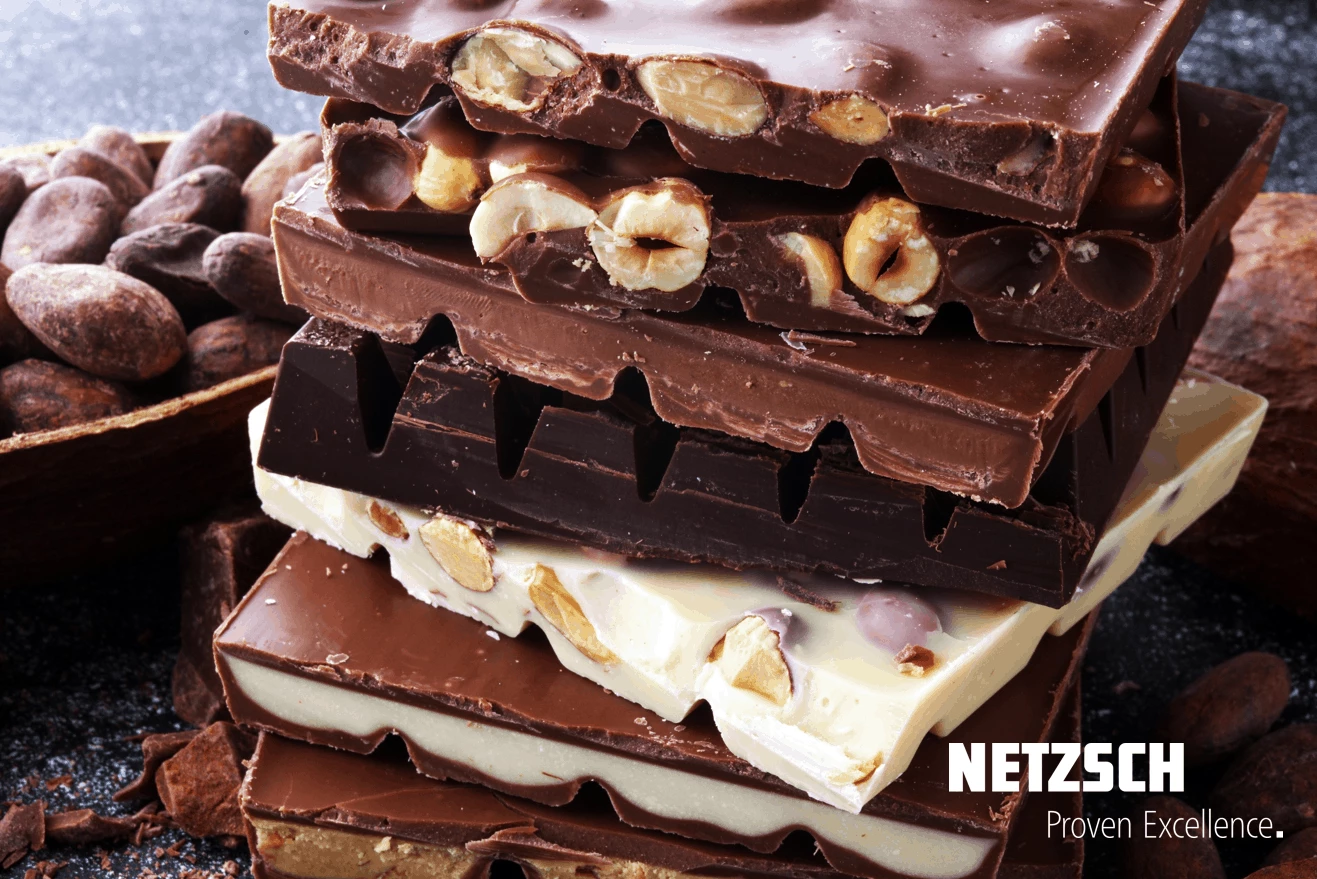
09.08.2023 by Philip Rolfe, Milena Riedl
Perfecting Delicious… Optimizing the Rheology of Chocolate
Chocolate is one of the world’s favorite snack foods. The texture, or mouthfeel, of chocolate is critical for the consumer perception of product quality. It is possible to finely control the textural aspects of the signature flavor of chocolates. The mouthfeel can be characterized through the determination of flow ‒ by rheology. Learn how to do this in our article!
Chocolate is one of the world’s favorite snack foods. In 2017, Switzerland topped the ranking of the highest chocolate consumption per capita. Citizens ate nearly nine kilos of the sweet deliciousness that year.
The unique appeal of chocolate lies in its taste, aroma and mouthfeel. These three attributes combine into the complex flavor of chocolate. As the natural ingredients of chocolate vary according to growing conditions, chocolate manufacturers go to some lengths to ensure the flavor of their chocolate products is consistent with their signature flavor. Ensuring that the signature flavor is replicated across batches requires correlation of analytical techniques with expensive sensory testing. Sensory testing every batch is not really practicable, however desirable that job might be!
What makes chocolate perfect?
Several factors are considered important for increasing the appeal of chocolate.
These include:
- Melting Temperatures and EnthalpiesThe enthalpy of fusion of a substance, also known as latent heat, is a measure of the energy input, typically heat, which is necessary to convert a substance from solid to liquid state. The melting point of a substance is the temperature at which it changes state from solid (crystalline) to liquid (isotropic melt).Melting temperature of well below 37°C, so that it melts in the mouth
- Shine, so that it looks appealing
- Smooth texture, which gives a pleasant mouthfeel
- Snap, so there is an initial “bite”
The flow properties of the fat phase (cocoa butter, which may be mixed with other fats) control how the chocolate coats the mouth and influences the perception of flavor. The flow, or rheological, properties of the chocolate also have significant impact on the chocolate manufacturing process. Reducing the particle size increases viscosity, potentially causing blockages as the liquid chocolate is piped through the factory.
The final product may be a bar, or tablet, of solid chocolate, or the chocolate may be used in an enrobing process to surround a filling center. Chocolate for enrobing processes is often optimized to achieve good coverage and may have a different recipe than chocolate for tablets.
Rheological testing for the perfect chocolate
The most fundamental rheological measurement made on chocolate is a viscosity measurement. A small quantity of sample is sheared at a fixed shear rate (speed), and the stress (force) required to achieve this shear rate is measured. The shear viscosity can then be calculated by dividing the shear StressStress is defined as a level of force applied on a sample with a well-defined cross section. (Stress = force/area). Samples having a circular or rectangular cross section can be compressed or stretched. Elastic materials like rubber can be stretched up to 5 to 10 times their original length.stress by the shear rate.
Effects of temperature on the viscosity of chocolate
The viscosity-temperature profile of a chocolate is of critical importance when optimizing the formulation and tempering process, and even the environment of consumption needs to be considered. It’s interesting, for instance, that the Melting Temperatures and EnthalpiesThe enthalpy of fusion of a substance, also known as latent heat, is a measure of the energy input, typically heat, which is necessary to convert a substance from solid to liquid state. The melting point of a substance is the temperature at which it changes state from solid (crystalline) to liquid (isotropic melt).melting point of chocolate used to enrobe ice cream bars (choc-ices, etc.) needed to be reduced significantly. This is because when someone eats an ice cream bar, their buccal temperature drops significantly and a standard chocolate formulation doesn’t melt under these conditions. The net result of coating ice cream with a standard chocolate is that it gives only a slight cocoa flavor; but also the mouthfeel of ice cream with hard pieces in it. Fortunately, the rheology of solid chocolate can be fully characterized with an oscillation temperature ramp from below to above the Melting Temperatures and EnthalpiesThe enthalpy of fusion of a substance, also known as latent heat, is a measure of the energy input, typically heat, which is necessary to convert a substance from solid to liquid state. The melting point of a substance is the temperature at which it changes state from solid (crystalline) to liquid (isotropic melt).melting point as shown in Figure 1. This allows formulators to optimize the bite of the solid chocolate bar and also the flavor of the chocolate to be fully tasted above the Melting Temperatures and EnthalpiesThe enthalpy of fusion of a substance, also known as latent heat, is a measure of the energy input, typically heat, which is necessary to convert a substance from solid to liquid state. The melting point of a substance is the temperature at which it changes state from solid (crystalline) to liquid (isotropic melt).melting point.
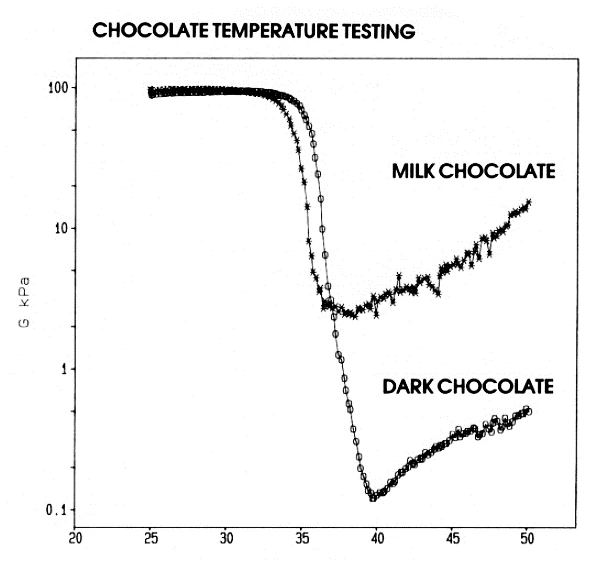
For less viscous chocolate syrup, viscometry tests can be used. It is notable that the viscosity is formulated to drops by almost two orders of magnitude around 18-24°C as seen in Figure 2:
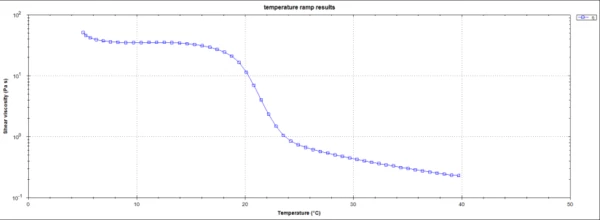
Viscosity of dark, milk and white chocolates
Dark, milk and white chocolates from a single range and brand of chocolate were selected for measurement to minimize variations in the chocolate manufacturing process and ingredient variation. The measurements were carried out with NETZSCH Kinexus Rheometer. The particulate ingredients of dark, milk and white chocolates are shown in Table 1.
Table 1: The particulate ingredients in different types of chocolate
| Cocoa Solids | Sugar | Milk Powder | |
| Dark | Y | Y | |
| Milk | Y | Y | Y |
| White | Y |
The dark chocolate has the lowest viscosity across the measured shear rate range and will be easiest to pipe around the plant (Figure 1). Interestingly, the milk chocolate has a higher viscosity but a similar yield StressStress is defined as a level of force applied on a sample with a well-defined cross section. (Stress = force/area). Samples having a circular or rectangular cross section can be compressed or stretched. Elastic materials like rubber can be stretched up to 5 to 10 times their original length.stress to the dark chocolate (Table 2). This suggests the milk chocolate and dark chocolate will have similar “slump” properties and will fill molds in a similar way. The white chocolate has the highest viscosity over the range and the highest yield StressStress is defined as a level of force applied on a sample with a well-defined cross section. (Stress = force/area). Samples having a circular or rectangular cross section can be compressed or stretched. Elastic materials like rubber can be stretched up to 5 to 10 times their original length.stress by some margin. White chocolate is known to students of cookery and confectionery as being the most difficult to work with, and in this case, it certainly has very different rheological properties.
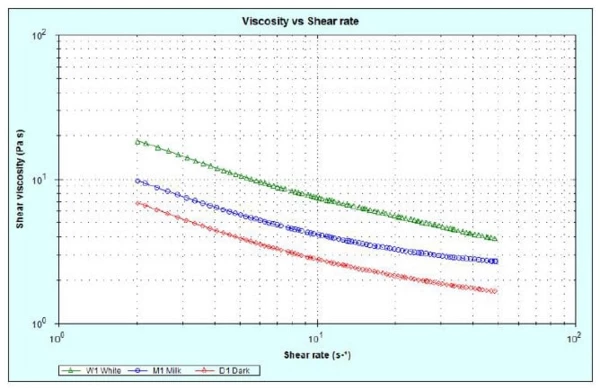
Table 2: Yield stress and shear viscosity for dark, milk and white chocolates produced by the same manufacturer
How to optimize processing of chocolate
Further insights into the rheological properties of chocolate can be determined using oscillatory testing on a rotational rheometer. This provides additional information about the viscoelastic properties of chocolate through the Elastic modulusThe complex modulus (elastic component), storage modulus, or G’, is the “real” part of the samples the overall complex modulus. This elastic component indicates the solid like, or in phase, response of the sample being measurement. elastic modulus (G’), Viscous modulusThe complex modulus (viscous component), loss modulus, or G’’, is the “imaginary” part of the samples the overall complex modulus. This viscous component indicates the liquid like, or out of phase, response of the sample being measurement. viscous modulus (G’’) and phase angle (δ). It also provides an alternative method to steady shear testing for determining the yield StressStress is defined as a level of force applied on a sample with a well-defined cross section. (Stress = force/area). Samples having a circular or rectangular cross section can be compressed or stretched. Elastic materials like rubber can be stretched up to 5 to 10 times their original length.stress.
The elastic and viscous moduli relate to the microstructural characteristics of the chocolate and can be used to probe component interactions and melting characteristics of chocolate by evaluating the solid-like and liquid-like properties.
The yield StressStress is defined as a level of force applied on a sample with a well-defined cross section. (Stress = force/area). Samples having a circular or rectangular cross section can be compressed or stretched. Elastic materials like rubber can be stretched up to 5 to 10 times their original length.stress, which is the StressStress is defined as a level of force applied on a sample with a well-defined cross section. (Stress = force/area). Samples having a circular or rectangular cross section can be compressed or stretched. Elastic materials like rubber can be stretched up to 5 to 10 times their original length.stress required to break down the solid structure and make it flow, influences how the chocolate will coat the molds and how well the chocolate will cling to the walls of the mold or slump before it sets.
Oscillatory measurements are non-destructive tests, which show how the material behaves under small deformations or forces ‒ before the material yields and starts to flow. The StressStress is defined as a level of force applied on a sample with a well-defined cross section. (Stress = force/area). Samples having a circular or rectangular cross section can be compressed or stretched. Elastic materials like rubber can be stretched up to 5 to 10 times their original length.stress or StrainStrain describes a deformation of a material, which is loaded mechanically by an external force or stress. Rubber compounds show creep properties, if a static load is applied.strain region in which this behavior occurs is known as the linear visco-elastic region (LVR).
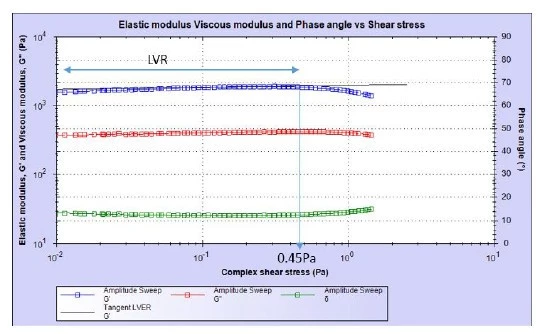
By measuring G’ as a function of shear StressStress is defined as a level of force applied on a sample with a well-defined cross section. (Stress = force/area). Samples having a circular or rectangular cross section can be compressed or stretched. Elastic materials like rubber can be stretched up to 5 to 10 times their original length.stress, the yield StressStress is defined as a level of force applied on a sample with a well-defined cross section. (Stress = force/area). Samples having a circular or rectangular cross section can be compressed or stretched. Elastic materials like rubber can be stretched up to 5 to 10 times their original length.stress of the structure can be determined ‒ this is generally taken as the StressStress is defined as a level of force applied on a sample with a well-defined cross section. (Stress = force/area). Samples having a circular or rectangular cross section can be compressed or stretched. Elastic materials like rubber can be stretched up to 5 to 10 times their original length.stress at which G’ starts to drop and the LVR ends. It is important to note that different Yield StressYield stress is defined as the stress below which no flow occurs; literally behaves like a weak solid at rest and a liquid when yielded.yield stress methods may give slightly different answers. For example, Casson and Windhab models are commonly used for determining the Yield StressYield stress is defined as the stress below which no flow occurs; literally behaves like a weak solid at rest and a liquid when yielded.yield stress of chocolate by extrapolating a steady shear plot of shear stress vs shear rate to zero shear rate. Although oscillatory testing is less common, it has been shown to be able to better resolve differences between chocolates. For the milk chocolate tested, the Yield StressYield stress is defined as the stress below which no flow occurs; literally behaves like a weak solid at rest and a liquid when yielded.yield stress was found to be 0.45Pa (Figure 4).
Rheology ensures chocolate product quality
The texture, or mouthfeel, of chocolate is critical for the consumer perception of product quality. By correlating expensive sensory testing with analytical results, it is possible to finely control the textural aspects of the signature flavor of chocolate brands. The mouthfeel can be characterized through the determination of flow ‒ by rheology.
Sources
www.howitworksdaily.com/why-is-chocolate-so-tasty
Chan, F. and De Kee, D. (1994) Yield stress and small amplitude oscillatory flow in transient networks. Industrial & engineering chemistry research, 33(10), p2374-2376
De Graef, V., Depypere, F., Minnaert, M., & Dewettinck, K. (2011). Chocolate Yield StressYield stress is defined as the stress below which no flow occurs; literally behaves like a weak solid at rest and a liquid when yielded.yield stress as measured by oscillatory rheology. Food Research International, 44(9), 2660–2665.